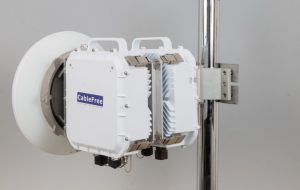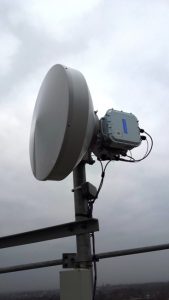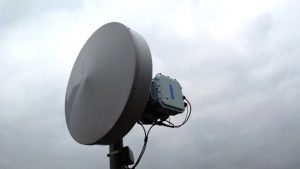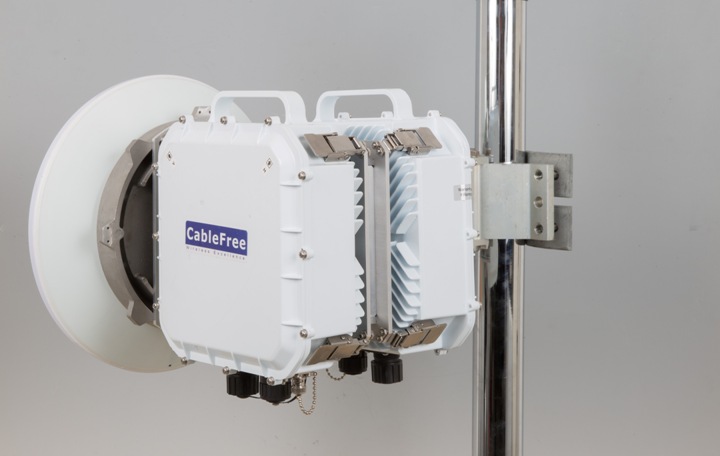CableFree MMW links with 2+0 aggregation offer 20Gbps Full Duplex Capacity
CableFree Millimeter-Wave radios are available in 2+0 configurations which double the capacity and resilience of a wireless MMW link, with many benefits to operators and end users.

What is 2+0?
2+0 means two radios combined onto a single antenna. Having two radios doubles capacity and increases resilience – with the radios operating on different polarisations (Horizontal and Vertical) to ensure complete isolation between the two paths. By comparison, a conventional 1+0 radio denotes a single radio connected to a single antenna, with no resilience or aggregation.
Benefits of a 2+0 Configuration
Customers deploying a 2+0 Millimeter Wave link can benefit from increases in Capacity, Resilience, Upgradability, Cost of Ownership, Aesthetic & Environmental Impact:
Twice the Capacity

This MMW configuration uses two separate paths through the air, each carrying up to 10Gbps, giving total 20Gbps full duplex capacity. Comparable to fibre networks, MMW is almost always lower cost, and without the delays in digging and provisioning.
Twice the Resilience
Two completely separate radios ensures complete resilience of all active items in the deployment, including cabling up to the radios. This means that no single outage or failure – power, cables or equipment – can cause network outage. In the rare case of outage on one path, the other keeps operating without interruption or packet loss, ensuring continuous uptime of the network, at half the overall capacity. The radios can be powered from separate power supplies and UPS as well for the ultimate in resilient wireless infrastructure.
Upgradability
A MMW link can be deployed as 1+0 and upgraded to 2+0 at a later date, when network traffic increases requiring scaling up of the solution. With additional “stacking”, a dual 2+0 system offers 4+0 capacity of up to 40Gbps full duplex, which is a record capacity in commercially-available wireless transmission.
Cost of Ownership
A CableFree MMW link is usually far lower in cost than a comparable fibre optic network, whether digging up the ground for new ducts, or leasing fibre circuits from a telecom provider. Some customers report 70% cost savings compared to a fibre network. An MMW link is generally a capital purchase item, which can be accounted for as an asset and depreciated, compared to leased fibre which counts as pure OPEX (Operational Expenditure) cost. If customers require leasing of MMW links to spread costs, this can often be arranged. In many countries, MMW frequencies are licensed with an inexpensive “light license”: examples are just £50 per year in the UK and only $75 for a 10-year license in the USA.
Minimal Footprint & Visual Impact
A single compact antenna is required on each site, with two radios connected. This greatly reduced space required on sites especially for heavily loaded masts and landlord rooftops in busy city areas, where space is at a premium with aesthetic considerations and building owner permission additional considerations. If needed, the antennas can be concealed behind windows, radomes or painted in colours to match rooftops or walls.

Fully Independent Link Paths
At a radio and network layer the links appear as independent links which gives operators complete freedom to provision traffic as they wish across the links. If traffic aggregation is required, this can be done using various different techniques at the IP layer, with complete flexibility.
“Better than Fibre Optics” solution
Compared to fibre optics, the 2+0 MMW has increased resilience: fibre optics is fragile, and can be fractured at any point along its length by digging and building works. Two fibres in one duct are no more resilient than one in the case of a fibre break – usually the whole cable is severed, and can take days or weeks to locate and repair. In the MMW installation, the path between the ends is just the air – nothing to break – and the active units, cables and power at either end are fully resilient. With 20Gbps full duplex capacity, the CableFree MMW solution offers fibre-like capacity without the wait. MMW can be fully deployed in hours, not days or weeks.
Safe & Environmentally Responsible
CableFree MMW links emit low power directional beams – around 1/10 the power of your mobile phone – and are typically located on rooftop locations well away from people. The units consume very little electrical power in use and can be powered by alternate power (Solar+Battery) on sites where there is no AC power available. Designed for long life, many CableFree products are still in use 10 or 15 years after installation, and can be moved to new sites if locations or requirements demand. At end of life, most materials in the products can be recycled. The total Carbon Footprint of a MMW deployment is considered to be lower than that of digging up city streets, plus disruption of traffic causing delays, emissions and more smog.
![]() PDF Version of this Application Note
PDF Version of this Application Note
For Further Information
CableFree has over 21 years experience with real-world deployment of wireless for mission-critical applications, with thousands of commercial deployments worldwide. For further information on Applications and Solutions for the range of CableFree wireless networking products please Contact Us


You must be logged in to post a comment.